The worst Mediterranean fires ever
This week: The worst ever fires; Some past island fires; Irrigation matters; Changing the emitters; More Mosquitos; Data mining; Looking back;
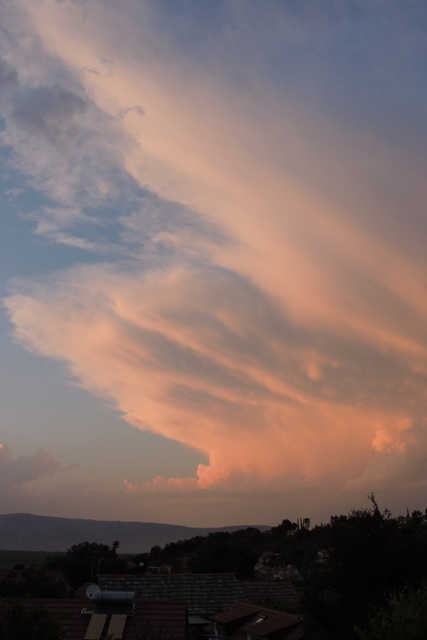
It has been another baking week. Not as hot as Sicily where the hottest ever temperature in Europe was recorded at 48.8ºC, but we are still above the average for the time of year.
With no sign of the weather changing. My weather station has recorded temperatures in excess of 37ºC several times this week.
Exactly at sunset, at 20:05 on Wednesday, there were some fantastic reflected colours on storm clouds which were over Kekezi in central Dalmatia.
This is to the north east of and around 50 kilometres away from Dol.
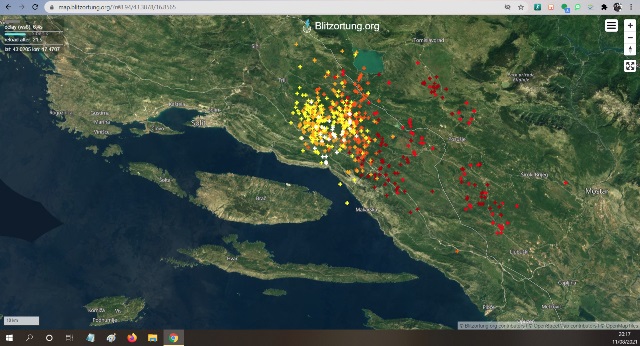
The actual storm was a single small cell, but very active. Streaks of lightning, both fork and sheet, were visible from my garden, but the most noticeable element were the Mammatus clouds.
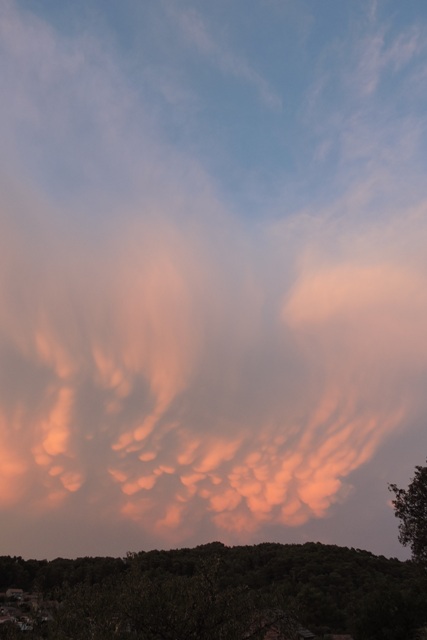
The base of clouds is normally flat because they form at a constant temperature point in the atmosphere where water vapour condenses.
However when there is an especially active storm, with significant downdrafts from the top or the anvil of the storm, then clouds are pushed out of the bottom layer.
These are often uniformly rounded in appearance, hence the name ‘Mammatus‘.
As the sun set over the horizon to the west, it lit the clouds from underneath. Just the very edge of the main Cumulonimbus storm cloud was visible (on the left).
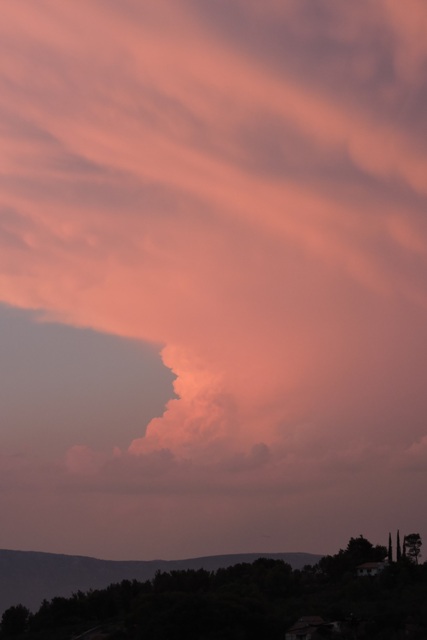
I would have to have been a lot further away to be able to see the whole cloud, but judging by the Mammatus, the top would have been at 10,000 meters (30K feet).
A lot of people across a wide area noticed these unusual clouds and posted their photographs to social media.
The IPCC report issued on Monday makes sober reading. We have moved from “climate change” to “climate breakdown”.
“..very serious harmful and in some cases irreversible changes in the world’s weather, as a result of human activity increasing the level of carbon dioxide in the atmosphere”
There is an informative video from the BBC weather centre towards the bottom of this “Our planet now” article, on climate change/breakdown and what it will mean to us.
The worst fires ever
There have been fires burning in various Mediterranean countries for several weeks. In fact since we had the first “heat dome” heat wave at the end of June.
However it is only in the last week to ten days that the media have really picked up on what is happening from Algeria, Sardinia and Sicily in the centre of the Mediterranean basin, through Greece to Turkey in the east.
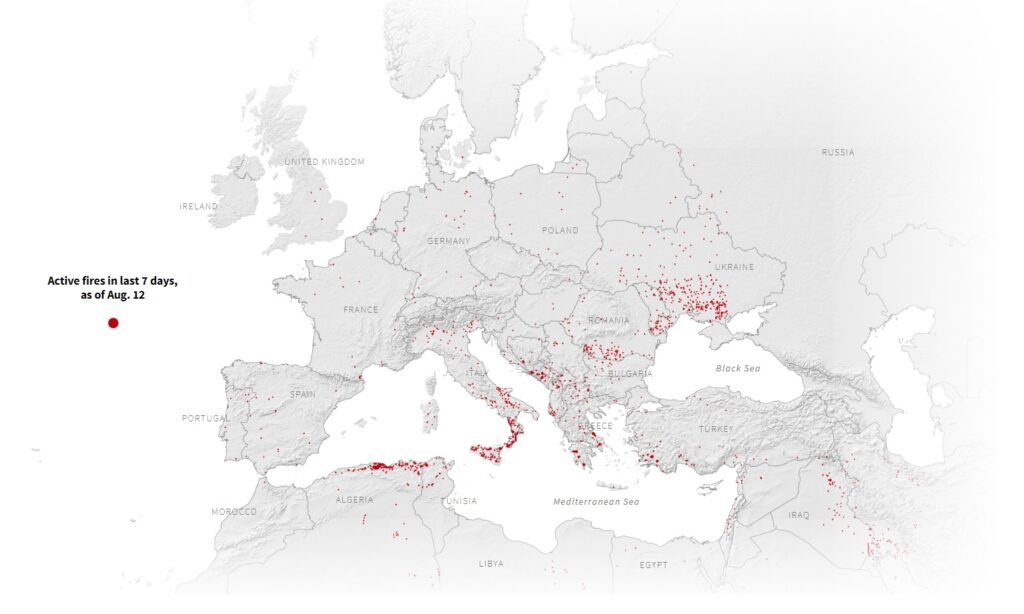
This week another heat wave has swept through, with both day and night temperatures well above the average for this week of the year.
The Reuters news agency have published a very good series of satellite photos and graphics showing the extent of the problems being faced in multiple countries.
A before and after satellite image of the island of Evia, close to Athens both shows the extend of the problem, but also what struck me was how similar Evia looks to Otok Hvar from that altitude.


It probably shouldn’t have surprised me because I regularly talk about the archetypical Mediterranean climate.
This is a climate where it is hot and dry in summer, mild and wet in winter and has the same basic flora and fauna throughout.
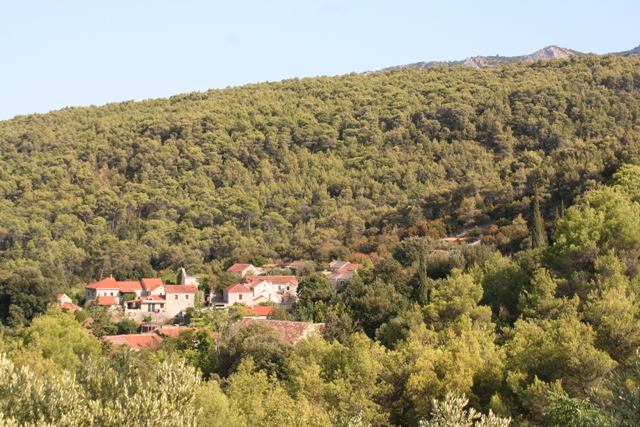
I took a walk this afternoon up into the Maquis behind my home. This reaches to within 20 meters of my wall along the old donkey track to the Church.
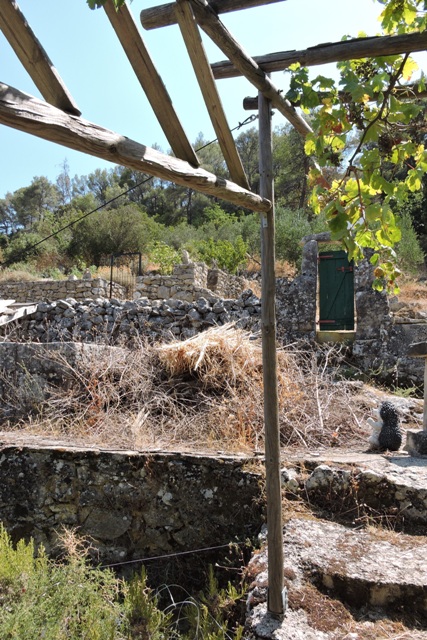
Forty or so years ago, these were serried ranks of cultivated terraces with olives, lavender and rosemary grown as crops.
Then young people started to leave the island, older owners stopped cultivating their terraces and the Maquis began to encroach.
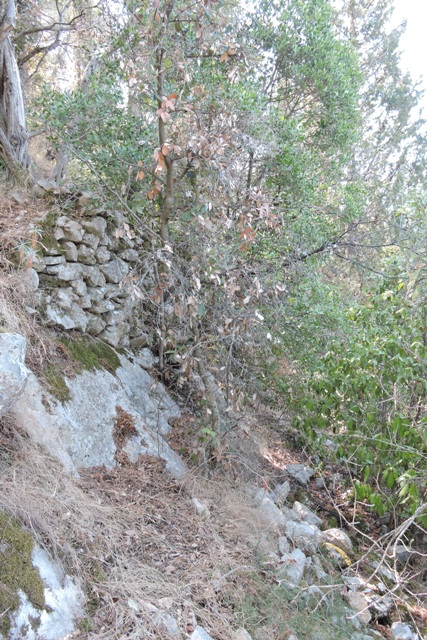
Under the canopy of the self seeded Pine and evergreen Oak trees, there is an impenetrable mass of dead branches, fallen pine needles and leaves, oily shrubs, dry grasses and bramble thickets.
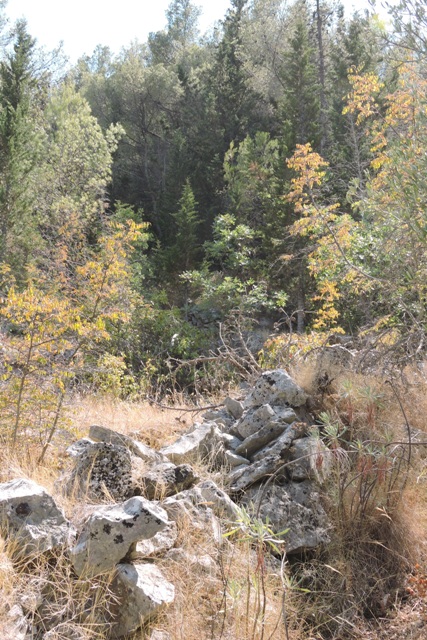
You can only get in here on foot. The donkey track is just wide enough for two people to pass, so no room for a 4×4 fire appliance.
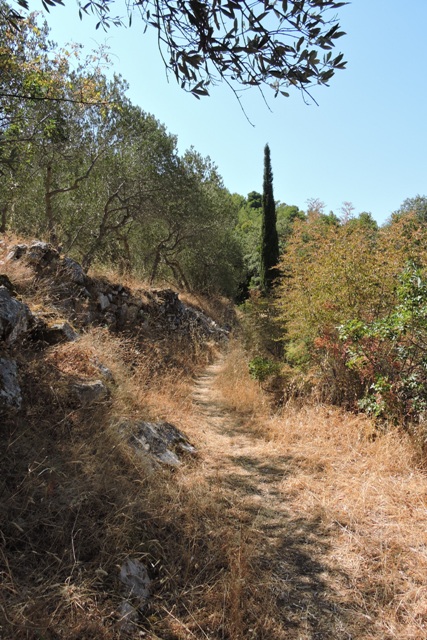
When I was helicopter fire training with the LA County Fire Brigade, I was given a copy of the Wildland Fire Incident Management Guide, a 200 page A4 manual for those responding to forest and wildland fires.
It is the sort of thing which you need to know intimately long before you are called to a fire.
It definitely isn’t the pocket guide which tells you what to do when you are presented with burning trees in front of you.
There is an even better manual, the Wildland Urban Interface – Operating principles which provides in great detail and with photos and diagrams, information about the behaviour of fire is areas like these around my home.
There are local rules here, but they are not complied with.
The understory should be cleared, but this comes back to the what I was writing about a couple of weeks ago, about the many unresolved issues of land ownership in Croatia.

Most of these terraces are owned by multiple people, some who have died, some who are living overseas and other locals who have a family dispute over who owns what and where.
This means that the requirement to have a 200 metre clear area around all properties like mine in Dol cannot be enforced when you don’t own the land.
This is because the complexities of the unresolved land ownership issues are just too great to solve.
Some past Island Fires
Fire is not a new threat in the Mediterranean.
Accidental and deliberate fires have been happening for centuries.
Drive on the old road from Stari Grad to Grad Hvar, via Selca and Brusje and the burnt stumps which are the remains of a 2003 conflagration can be seen on either side of the road.

There are no “old growth” trees left on the island. They were cut down centuries ago to provide wood for the shipbuilding industry, so everything which is still here is of recent origin.
Once the trees are gone, then plants begin to invade the newly created space.
The soils on the island are thin, with the limestone bedrock lying just underneath. So the plants which thrive are those which like thin, alkaline soils and can exist with little to no summer rainfall.
These plants tend to be evergreen with thick, glossy, oily leaves – just what you don’t want in a fire.
The trees that are here have been planted in the last 150 years or so, to stop runoff from the hillsides and are mainly Maritime and Aleppo pines.
They can grow in these conditions, readily self seed and even thrive in them. But being pines, they have vast amounts of oil in their wood, branches, fir cones and needles.
In a fire, an exploding fir cone can launch flaming segments tens of meters, so advancing the fire line. A crown fire is one of the most frightening wildland fires to experience.
2017 was a bad year. At the start of August, I saw this plume of smoke from my gate.
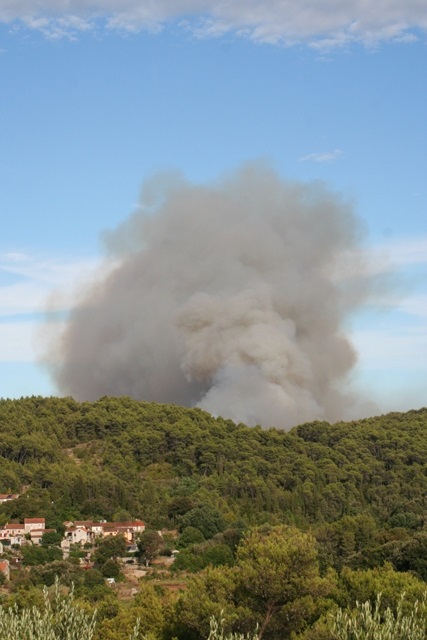
It was in the Maquis above Vrbanj, just 1,400 metres away. Fortunately the wind was blowing away from me.
These are before and after Google Earth images. Use the slider to view them
.

I drive past the scared landscape every time I go to the Post Office or to Jelsa.
It took the combined efforts of three Canadair water bombers and all the resources of the Vatrogasci from Stari Grad and Jelsa several hours to extinguish what was actually a relatively small blaze.
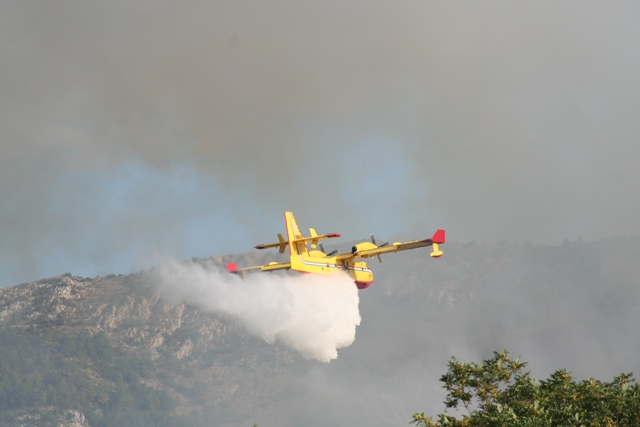
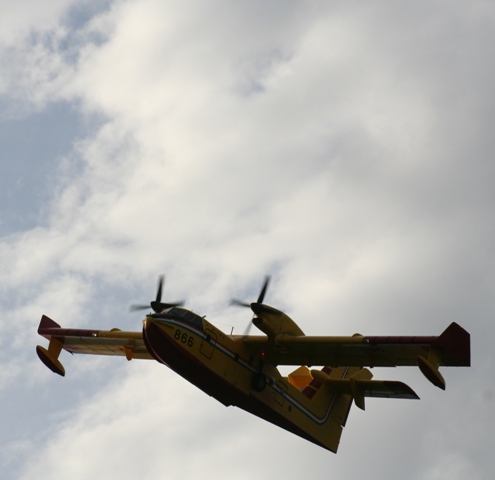
The same summer, there was a fire on the Piažice peninsula


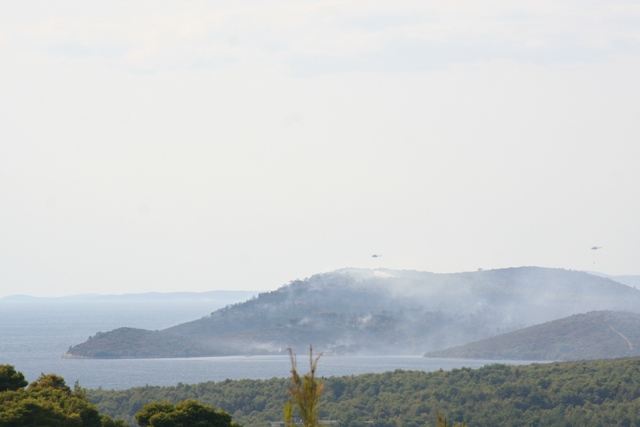
Two helicopters dropping water, plus the Vatrogasci extinguished the blaze, but the scars are still there, visible form the ferry every time you pass on your way to the Stari Grad Trajekt terminal.
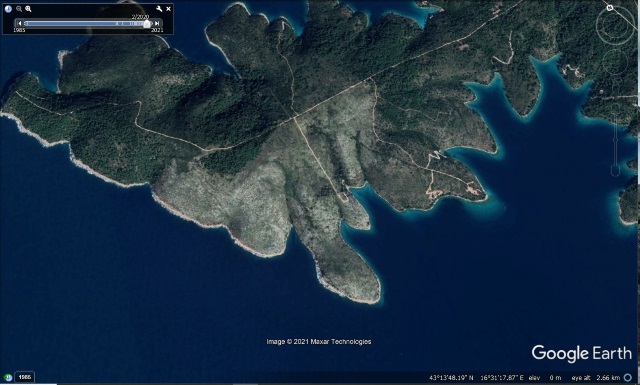
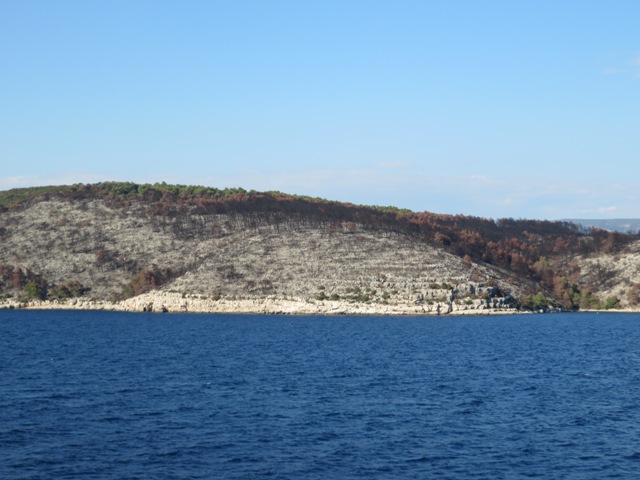
It takes decades for trees to re-establish after a fire, especially where any soil that there is, is very shallow.
The temperature crossed the 37ºC threshold a few minutes ago, for the third time this week, so I know that the possibility of a forest fire here, is an ever present summer threat.
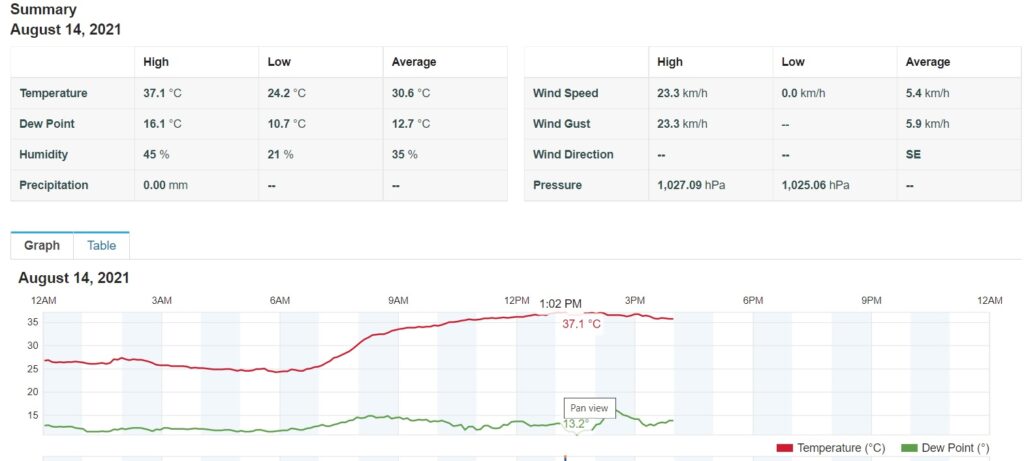
It is illegal to have a garden bonfire between 1st May and 1st October because of the threat of fire.
I suspect that as the climate breakdown continues, the length of the annual fire moratorium may have to be extended.
Our local brigade, the Vatrogasci, have some excellent almost new vehicles, but when there are no roads to get into the forested areas, it causes an immediate problem.
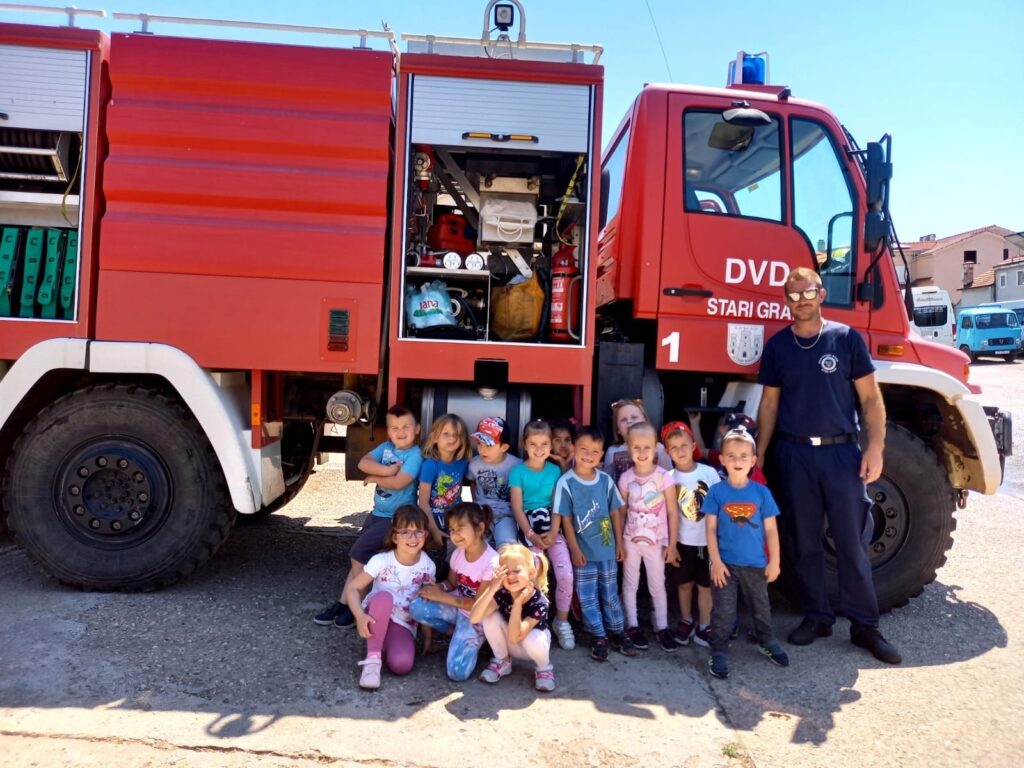
Add to that the fact there are no water hydrants in the village, so water must be tankered in, and firefighters having to fight the fire on foot doubles the difficulty.
There are a number of regional airborne resources, but they are on the mainland, may have been deployed elsewhere and they can only fly in daylight.
So I have my coils of hose ready, as a “just in case” mitigation measure, so in the event of a fire nearby, I could hold out until the Vatrogasci arrive….
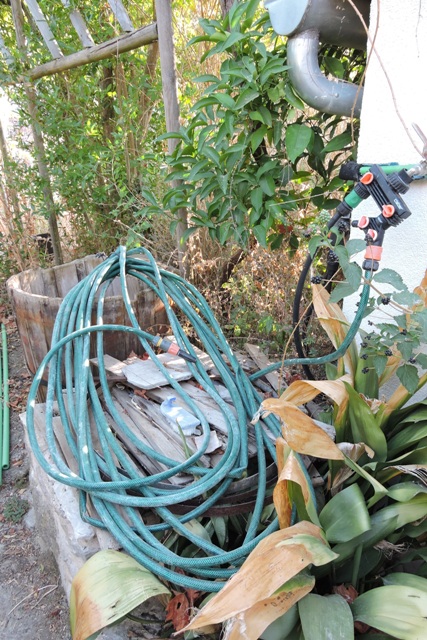
As the heat continues, there are a number of documents that are available, most of which make grim reading, for example the European Wildfires Information Bulletin.
Irrigation matters
Is that “Irrigation matters” or “irrigation Matters!“?
It is probably both. I have some irrigation issues to resolve and also irrigation is important.
One of the emitters blew out of the end of a pipe under a lemon tree again. I could hear water running and saw a stream of water coming out of the bare end of the microbore tube.
My pressure regulator for the irrigation pipe is how far I turn the tap on. You can spend hours working out the amount of water that is being delivered at any point in a system, but to what end?
In a greenhouse, where scientific experiments are being carried out, I can understand the need for precise measurement. Or when you are trying to grow some especially pernickety specimen which requires very precise growing conditions.
But in my orchards, it is about delivering water to young trees when the soil is dry and there has been no rain for months.
What I have found is that the small emitters have some flaws in their use.

Firstly they are black, which makes them difficult to see, especially when one has popped out of its tube and flown off somewhere.
Secondly, because they are designed to deliver very precise flow rates and are engineered to high standards, it means they easily become blocked and thirdly being small they are difficult to adjust when they are under a growing tree.
It was OK when I installed the system and the trees were just single stemmed saplings, but now as the trees grow, it has become more difficult to adjust them in the face of branches and foliage.
When I went to my spares box, there were no spare emitters. It is one of the things I may need to get in Split once the pandemic has subsided enough to make travel safe.
What I did have were some larger emitters, so I was able to fit one and get the system up and running again.
I need to thoroughly service the various irrigation systems that I have installed once the days cool. At the same time I think I will change most or at least some of the emitters. This will make them easier to find and to adjust.
Changing the emitters
I keep an accurate record of how much water I have used. This was a recommendation from my Solicitor when I moved in because the utility companies are not known for the excellence of their record keeping!
It is rather like when you pay for something in a shop. Items are always priced to the nearest Fil, but change is rounded up or down when you pay cash, because there is a lack of small change.
So sometimes you get more change than you should, sometimes less, but it probably evens itself out over time.
How at the end of a day anyone can reconcile the amount in the cash drawer with what the electronic till says should be there, goodness knows!
So because of my records, I can tell exactly how much water I have used, week by week. What I can’t say precisely, is how much is irrigation and how much domestic use.
However looking at the middle of winter, because my domestic use is about the same year round (perhaps fewer cold showers though!), I can estimate the irrigation water I use each week.
This year has been exceptional though because of the heat.
On Thursday morning I noticed that several of the trees in the citrus orchard were showing signs of stress, despite all my irrigation, so I decided to change the emitters.
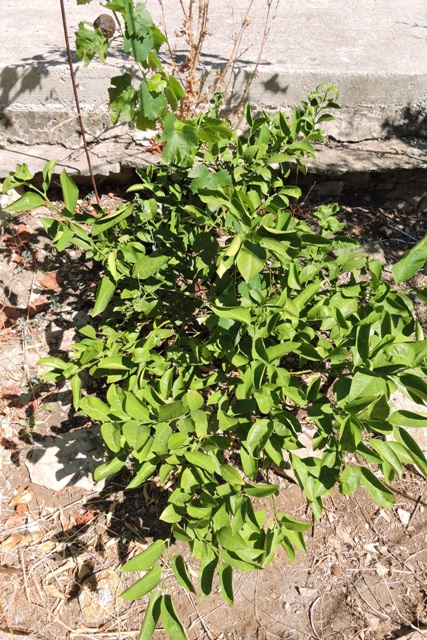
I have three of these large IKEA Samla boxes in the workshop, full of different irrigation fittings. They are something else that came with me from Abu Dhabi.
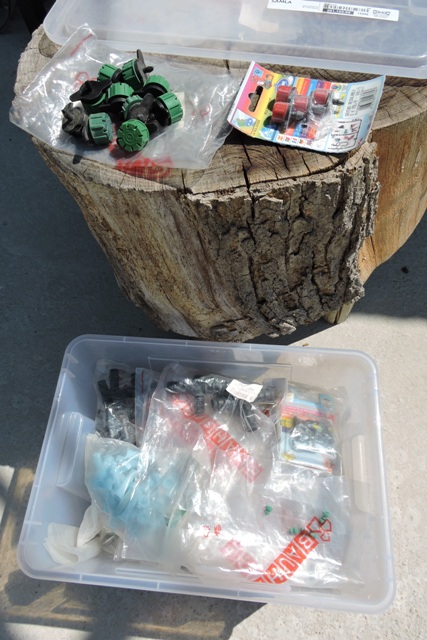
There were shops there which sold nothing but irrigation items. There is nothing to compare here, even at Bauhaus where they have a passable range of irrigation materials, but still a lot of gaps.
I found a bag of the green mini emitters and once the heat of the day was passed, you would have found me on hands and knees, under each of the trees in turn, locating its emitter.
There was then a process of changing each from the black tubes to the green mini sprays.
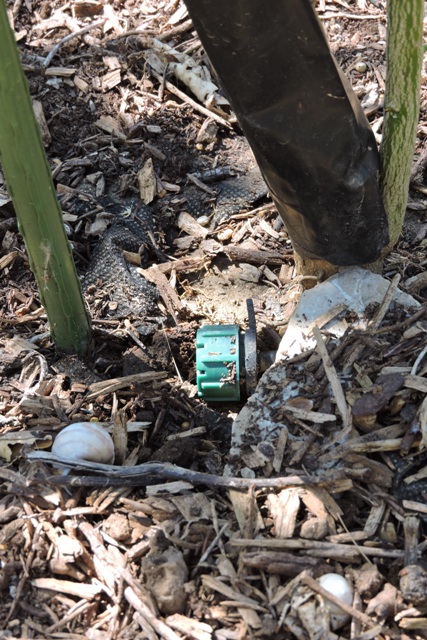
I turned each mini spray a single turn, so in theory they should all have the same flow and then turned the system on.
For some reason pressure was low on two pipes, so I opened the emitters a little wider, so each was providing the same amount of moisture.
Almost every emitter that I removed was just about blocked. I wonder where the water has been actually going to when I have turned the system on?
Because the system is a full circuit, the pressure should be the same everywhere. That is the theory at least!
Using the water meter, I then measured exactly ten minutes of flow. I had used 100 litres of water.
I’ve not done this kind of exact measurement before which I probably should have done.
More Mosquitos
I watched this week as one of the felines came in for breakfast, bringing an uninvited guest with him.
With three of the juveniles having a lot of white fur, it is easy to spot burs that they have picked up as they play in the grass. So a black shape on a white muzzle stands out.
It was one of the horrible Tiger Mosquitos, Aedes albopictus, that we have here.
This is an alien, invasive species which is believed to have arrived from the far east in a ship load of tyres 12 or more years ago and found the climate to their liking.
I swatted the wretch as it took off. It won’t be doing any more biting.
Later in the week, I found I had one on my wrist, which after taking a quick photo, I swiftly dispatched and then applied some Anthisan bite cream.

Only the female mosquitos bite and only the female mosquitos “buzz” as they fly.
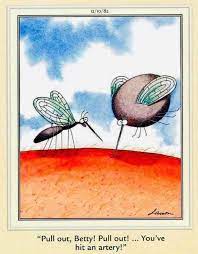
I use Dipterol as a repellent when I am outside, applied twice a day, sprayed on exposed skin. It works well, but only lasts a couple of hours.
However the spray is better than the “roll on” which left my skin feeling sticky.
Later I watched Pongo rubbing up against the bark of a lemon tree in the orchard. When I looked up the behaviour, it was because citronella, found in the bark, is a natural insect repellent.
By rubbing both sides of his face against the bark, he was using a natural substance to protect himself. Who says felines are unintelligent!
This year seems to have been especially bad for mosquitos and bites, more so than usual.
In the study I have had a different species, with a much higher pitched “buzz”. They were smaller too and more difficult to see and to swat.
I think I must be getting a little sad when I can start to differentiate different mosquito species by their characteristic sound…
The Municipality are aware of the problem, as most of the Mediterranean is, and sends a truck out to spray insecticide two or three times a year, but it never comes to this part of the village.
Reading up on the subject in the Journal of the European Mosquito Control Association, there is concern about the many serious diseases that mosquitos carry, as Europe warms.
I also discovered that there are 40 native mosquito species in Croatia and two that are invasive. The Asian bush Mosquito, Aedes japonicus, is here as well as the Tiger Mosquito.
As the climate changes, with winters and summers becoming warmer, it is yet another problem that will have to be dealt with sooner or later.
So if you happen to see me rubbing up against the bark of the orange, lemon and grapefruit trees in the orchard, you will know what I’m doing… 😉
Data mining
I realised this week that the amount of data that I gather each week, about various subject areas actually holds some valuable insights.
What started as just an exercise to make sure I wasn’t being ripped off, now means that I can look at data to see what is happening.
I changed the timing of the irrigation system last summer to give a single ten minute run, once per day, something I have continued again this year.
Previously I had given the system two five minutes runs, one in the morning and the other in the evening. That was time intensive but changing it didn’t seem to make any difference to the growth of plants.
On a very hot and sticky afternoon this week, I made some basic graphs for the past four years.
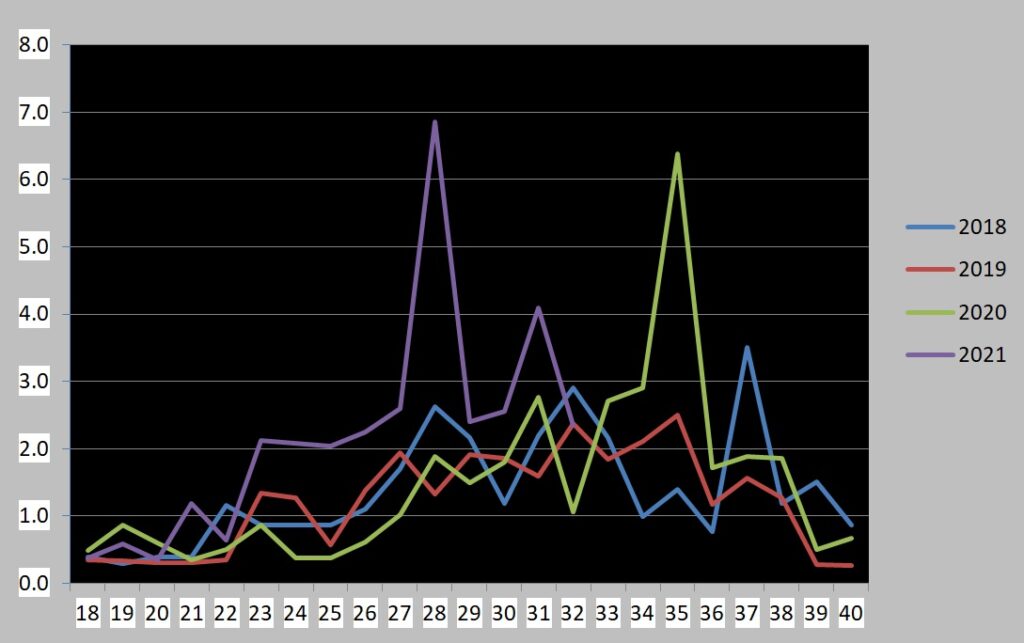
Especially this year, I was expecting that I would have used considerably more water than in the past. The graph actually shows that my water use in summer is remarkably consistent.
There are two abnormal spikes, where I have used 6m³ in a week. These are aberrations, when I accidentally left a system running overnight. But these apart, my water usage is statistically consistent.
During the winter months my domestic water use is an average of 1.25m³ a month, so taking that off the summer average of 8.5 m³ , I am using around 7,000 litters a month on irrigation.
It is very little when compared to my neighbour who fills a 1,000 litre trailer tank every day for his olive trees.
There is no flowing water on the island. The only permanent water is the Dračevica on Stari Grad Plain.
I’ve not been down there for 8 months, but I expect even Dračevica will be almost dry after the year we have had.
Our water comes from the mainland, via a large bore underwater pipeline to the island. It originates in the wet interior of the country where lakes, rivers and dams are plentiful.
In my time here there have been no restrictions on the use of water or hosepipes. However that does not mean than in the future, there will not be some.
I still have a small amount of water in my garden cisterns and this is an area where I think in the future, I may have to make improvements.
These cisterns were created from solid rock using dynamite in 1909, but some of their retaining walls are porous and the collection surfaces need to be repaired.
Waterproofing the insides to prevent leakage will not be an easy job, but it is one which I think may well be needed as the climate breakdown continues and intensifies. NCG
Looking back – Week 32
This is the start of a new weekly section, with links to past issues of the blog.
2014/32 Somewhere there is a punchline
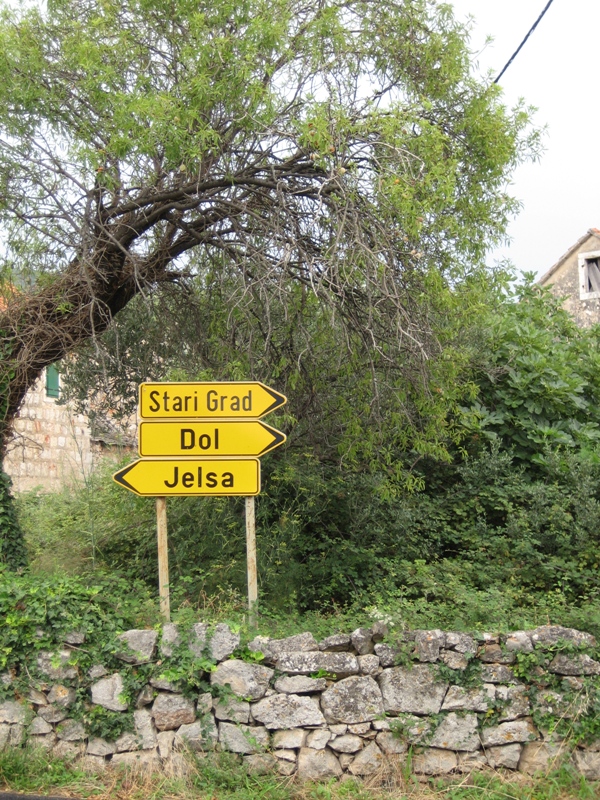
2015/32 Putting down roots
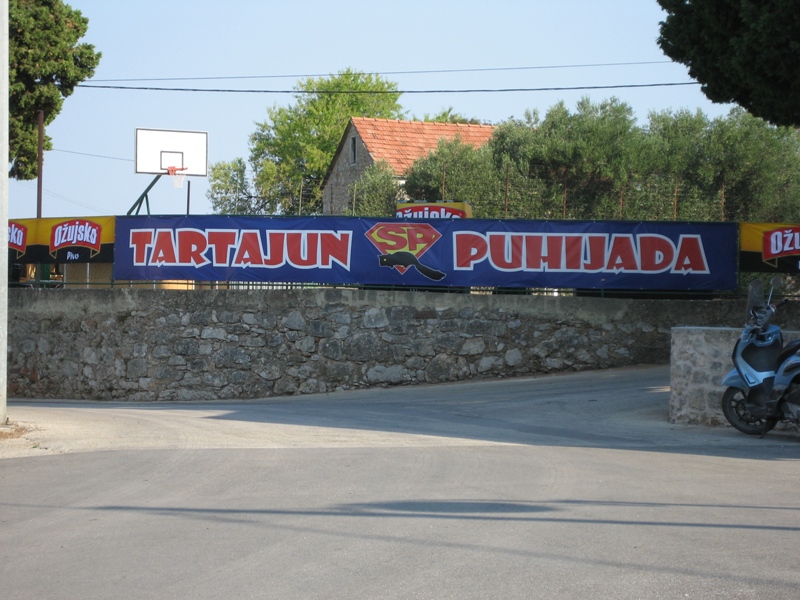
2016/32 I’ve been attacked!

2017/32 A short language guide to Dolski
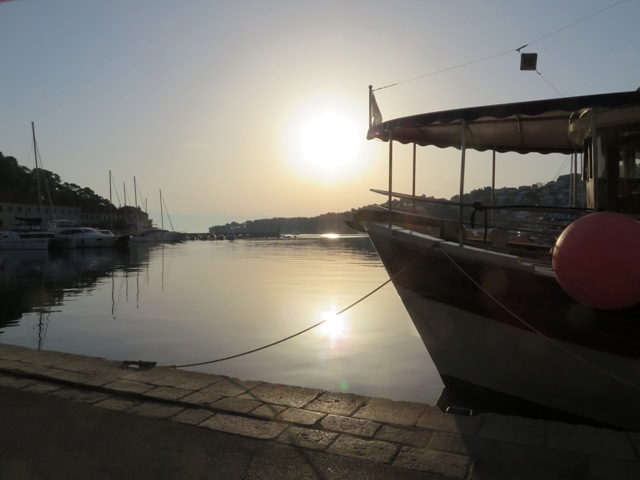
2018/32 Starting with a clean sheet
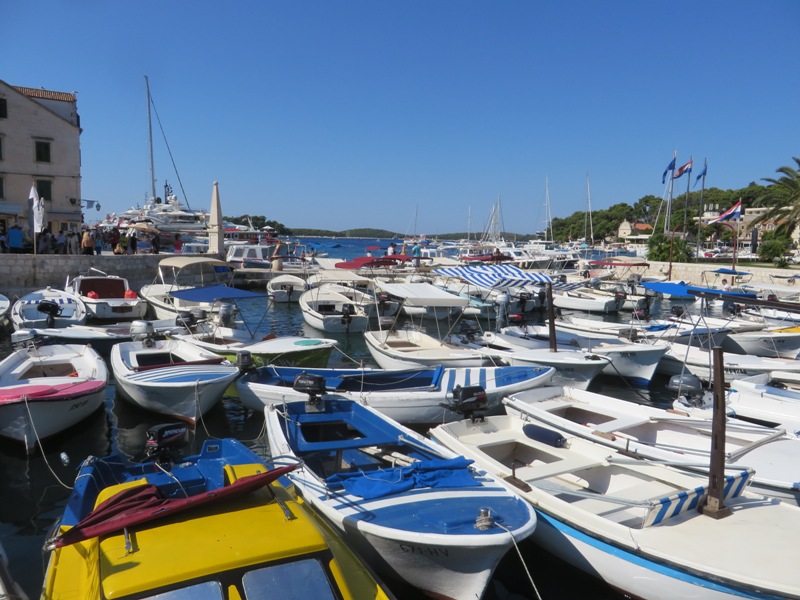
2019/32 EXIF Stage left

2020/32 The Open’s closed!

Mediterranean
2 Responses
Andy Robinson
Whilst reading about the fires I was worried that you would be vulnerable in your situation….silly me, of vourse you have hoses on standby in case of just such a conflagration I really should have known!
Marcy Fletchall
Hi Norman. An excellent blog, and so helpful to gain perspective on what’s happening in other parts of the world. Wildfires are abundant here, and the air quality is well below par. I have suffered and had to go to urgent care a few times this summer with my eyes. We have all been told to stay inside and run a/c because of the smoke. But soon the beautiful fall will be upon us, and the weather will be better. Heat waves across the US are unprecedented. I also liked the term climate breakdown. The planet won’t survive if we don’t take heed now.
As always, thank you for sharing, and stay safe. Marcy